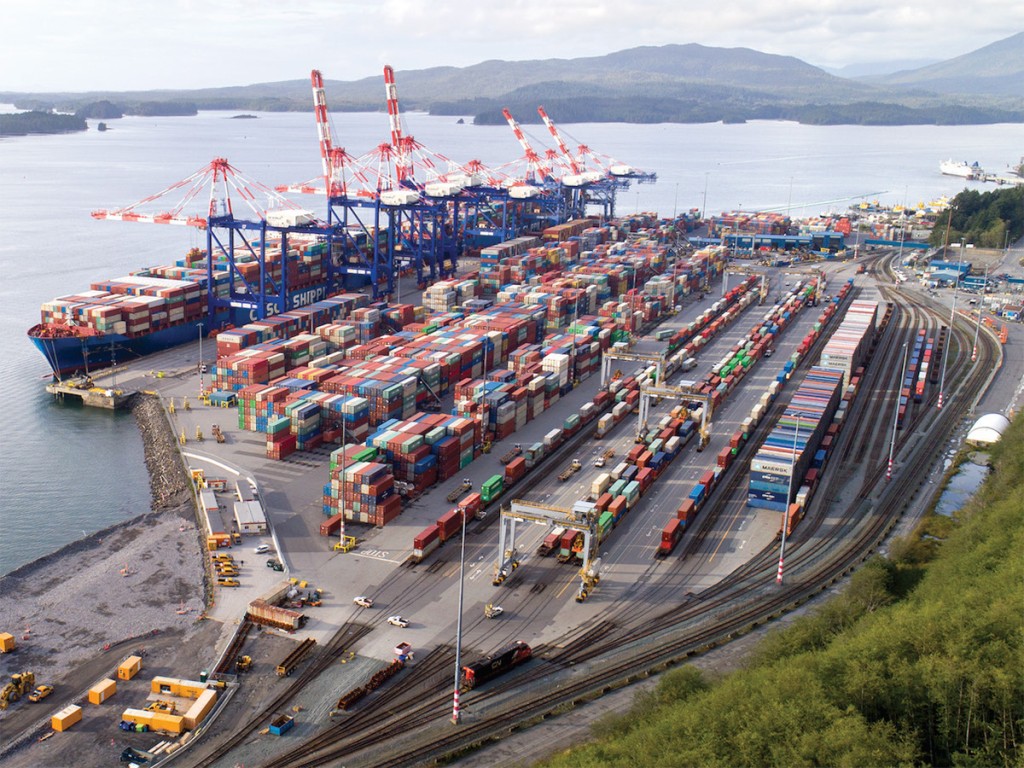
Situated in a remote location in northern British Columbia, there appears to be no stopping of the momentum driving the Port of Prince Rupert in recent years. From a struggling bulk facility two decades ago, it has among other things capitalized on its advantage as the closest port on North America’s west coast to Asia by up to three days sailing time to emerge as Canada’s third-leading container port – thanks in no small part, to a CN continental network and doublestack service to the U.S. Midwest.
Last year, Prince Rupert handled 24.6 million MT of cargo, about 2% behind 2021 throughput. Container volume amounted to just over one million TEUs.
“The Fairview-Ridley Connector Corridor, a critical component of the Prince Rupert Gateway’s intermodal ecosystem, is now operational,” he began.
Three years in the making, the five-kilometre stretch of road has since last August been drawing containers headed to the DP World Prince Rupert Fairview Container Terminal away from the central core and downtown city streets. It reduces the trans-loading haul distance to the terminal from 12 miles down to 3 miles for the more than 200 trucks moving containers daily.
“PRPA’s contracts awarded for the project to the Coast Tsimshian Northern Contractors Alliance (CTNCA), a local First Nations joint venture led by Prince Rupert Lax Kw’alaams Band and Metlakatla First Nation, as well as the related habitat compensation work, totaled more than C$135 million,” noted Friesen.
“Simultaneously, DP World Prince Rupert completed its southern expansion of the Fairview Container Terminal, bringing total capacity to 1.6 million TEUs, and connecting the two newly constructed developments through a new truck gate,” he explained. “In combination, the private haul road and new rail infrastructure that make up the Corridor directly link transloading and marine terminal operations within the Port’s existing footprint with Fairview Terminal and will be able to support efficient transport between future import and export logistics sites.”

C$2.5 billion infrastructure investments on horizon
Friesen continued: “I am pleased to share that the Prince Rupert Port Authority and a number of industry-leading commercial and Indigenous partners have a significant capital development portfolio slated for 2023 and beyond that are nearing final investment decisions this year. These projects collectively would represent the beginning of one of the most capital-intensive periods in the Prince Rupert Port Authority’s history, with approximately $2.5 billion in infrastructure investments expected to begin this year.”
Total container throughput for 2022 was down 2% from the previous year. “Despite transpacific intermodal import volumes trending downward in early 2023, the Port of Prince Rupert is in a strong position to grow market share,” opined Friesen. “DP World Prince Rupert’s most recent completed expansion at Fairview Terminal means that the Port of Prince Rupert has approximately 600,000 TEUs of available intermodal capacity today
“Furthermore, our active plan to develop capacity increases and transloading capabilities with our partners will ensure Prince Rupert plays a key role in servicing the overall growth in volumes expected in transpacific trade for Canada over the next decade – namely, the Fairview Terminal expansion to 1.8 million TEUs, the Ridley Island Export Logistics Project, the South Kaien Import Logistics Project, the proposed Second Container Terminal, and the various enhancements to the connecting infrastructure serving the port complex.”
Casting his eyes on the outlook, Friesen declared: “With our growth and diversification ambitions over the next five to ten years, the Port of Prince Rupert is in its most ambitious period of expansion which will support Canada’s trade objectives in the Indo-Pacific region. Given our leveraged natural advantages as the first port of call on the West Coast for Asian trade and our established global reputation for speed, reach, and reliability, we will be in an even stronger position in the future to offer more diversified, full service intermodal handling options for Canada’s growing import and export needs as our gateway matures in its business proposition.”





